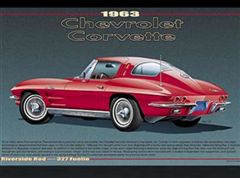
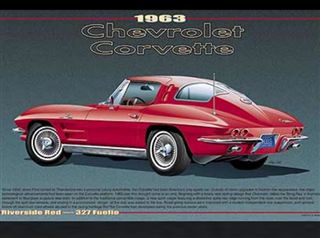
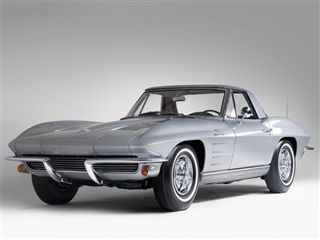
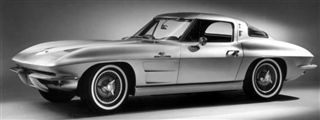
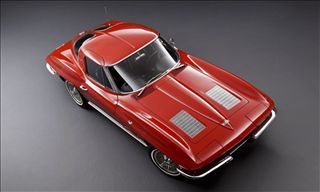
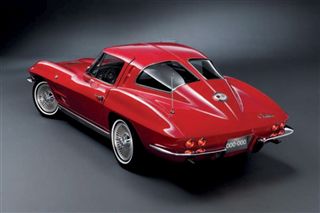
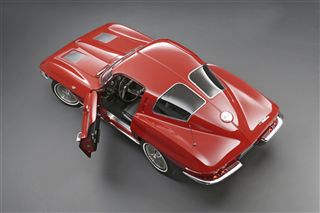
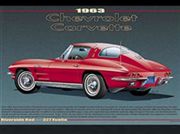
Few cars have captured the imagination of the Sports car set like the 1963-67 Sting Ray, the sleek and slippery all-new generation Corvette that previewed a host of styling and engineering innovations for Chevrolet. Four-wheel independent suspension and concealed headlamps topped the list of improvements that arrived with the new styling of ’63, and by the model’s final season 1967, many new and exciting features had been added, such as four-wheel disk breaks and the availability of big-block power. All of these achievements were delivered within the guise of the basic package and not at the expense of the Corvette’s original concept – that of a two-passenger, fiberglass-bodied sports car with good handling and excellent acceleration. By 1967, all of the Sting Ray’s virtues had been thoroughly reviewed, analyzed and refined. It carried most of the state-of-the-art engineering available at the time to Chevrolet, and its styling had been only modestly revised (but the changes were all noticed and appreciated by Corvette followers). And, the Corvette has always had its own cult following…and still does! The first edition Sting Ray had matured significantly by the time it made its final appearance in 1967. Chevy designers and engineers had, as the saying goes, really “dialed in” their sports car by then. It looked powerful, with clean, flowing lines that cheated the wind and gently sculptured fenders that excited the eyes. Most important, it didn’t disappoint when thrust into motion. This is one car that delivered on its promise of excitement in straightening out a curvy road or blistering through a quarter-mile run at the local strip. However, to take on the competition, which was quite formidable by 1967, Chevy had to field a line of big-block V-8s second to none in performance and durability. The first big-block had appeared in 1965 in the form of the 396-cid V-8 rated at 425 horsepower. Again in ’66, only one big-block was offered, but it was a 427-cuber, also with a 425 hp rating. It was this model that would take the crown as the fastest stock Corvette ever, posting a quarter-mile time of 12.8 seconds and a top speed of 112 mph. It had a single four-barrel carb. The only other car in street clothes that could beat the ’66 big-block Vette was the totally awesome ’66 A.C. Cobra, which managed a quarter-mile blitz of 12.2 seconds at 118 mph. The Cobra, of course, was sensational, but it was also little more than a set of wheels with a go-kart size frame and the most ferocious motor Ford produced at the time. The Corvette offered some civility with its sizzling performance. Chevy improved on the package for 1967, al last in terms of user compatibility, but the performance dipped measurably. The big-block line was expanded to three versions of the 427-cid V-8. The first featured a single four-barrel carb and was rated al 390 hp; the other two were both crowned with tri-power and sported power ratings of 400 and 435. There was also a very especial racing version of the 427, the legendary L-88. This totally awesome engine was conservatively rated at 430 hp. Only 20 were made, and each was sold at an incredible $948. The three production big-blocks were a lot cheaper, and much easier to live with in day-to-day use, or weekend competition. The L-88 was reserved for the super serious competitor. The base engine was, of course, a small block. It displaced 327 cubic inches and was rated at 300 hp. Optional was a second small block, another 327, but one rated at 350 hp. Next came the big guys – the fearsome foursome of big-blocks. The quartet of big-blocks all shared the same basic dimensions with a bore and stroke of 4.25 X 3.76 inches. Other common characteristics included a cast iron block, overhead valves, 90-degree V construction and normal oil pressure of 30 to 35 psi. But, that’s where the similarities ended. The junior member of the team, the L-36, rapped out 390 hp at 5,400 rpm and sold for $200. It relied on a single four-barrel carburetor, had 10.25:1 compression and came with hydraulic lifters. Next up the ladder was the L-68, which developed 400 hp at 5,400 rpm and used a trio of Holley two-barrel carbs. Compression was again at 10.25:1 and hydraulic lifters fitted. This option listed for $306 and was ordered by 2,101 Vette buyers in 1967. Both the L-36 and L-68 developed the same amount of torque – 460 lbs.-ft. at 3,600 rpm. The premium 427 was the incredible L-71, the motor powering the feature car. Rated at a healthy 435 hp at 5,800 rpm, this mighty mill had a torque rating of 460 lbs.-ft. at 4,000 rpm. It also used tri-power, with three Holley deuces atop an aluminum intake manifold. Features included mechanical lifters and a special cam, and compression jumped to 11:1. The monster mill delivered its 435 horses with a bang, but it took a few bucks to put one of the so-called porcupine engines under the hood of your new ’67. The retail tag of $437 (plus $184 for the mandatory four-speed tranny) kept installations to 3,754. The last member of the big-block quartet, the aforementioned L-88, is pure animal. Intended strictly for the serious competitor (as evidenced by its $948 sticker price), the L-88 was listed at 430hp, but that was really a joke. Something around 500hp has been called conservative. Also a joke was the $948 option price, because the L-88 automatically mandated certain other options, such a heavy duty power disc brakes, heavy duty suspension, transistor ignition, the heavy duty “rock crusher” four-speed transmission, and Positraction rear axle – the L-88 could not be delivered with a heater or defroster, so a $98 credit was given for equipment deletion. The L-88’s list of credentials was impressive, presenting such hardware as a single 850-cfm Holley four-barrel carb, special lift cam, 12.5:1 compression pistons, heavy-duty clutch, heavy-duty aluminum radiator, special valves springs and spring caps, heavy-duty rocker arm balls, and a unique air filtration system with the special scoop providing air pickup at the base of the windshield instead of at the front of the hood. The “animal motor” came with several stern warnings from Chevrolet that the L-88 was an off-road engine and was not emission certified, nor was it capable of handling state-of-the-art pollution control equipment. Also, the engine required a minimum of 103 octane fuel. Chevy issued this caution to would-be L-88 owners: “The L-88 gives a rough idle, is not the easiest engine to start and was not designed with high fuel economy in mind. As a matter of fact, the L-88 requires higher octane gas than most stations carry.” For obvious reasons, L-88 production was miniscule. Only 20 of the monsters were unleashed in 1967 (followed by another 80 the following year and 116 in 1969, the third and final season for the legendary L-88). But, for the more conventional performance enthusiast who confined his thrills to the streets the L-88 was impractical. So, he turned his attention to the equally exciting but not quite as radical 435-hp street version of the 427. And, this engine proved more than adequate for even the most daring of sports car aficionados. Its awesome strength can be felt in a rush that might be compared to an astronaut rocketing into space. It’s an all-consuming blast that seems to last forever but is, in reality, over in a flash. In a mere 5.5. seconds one can be moved from a dead stop to 60 mph, while the quarter-mile stretch takes a bit longer, about 13.8 seconds with a closing speed of 108 mph. With a little fine tuning, the 435 would do even better and it did in the hands of dag-racing enthusiasts around the country. The 425 and 435 Vettes of 1966 and ’67 are still blowing competitors of all ages and descriptions into the weeds growing alongside drag strips across the country.
Source: |
 Options
Options